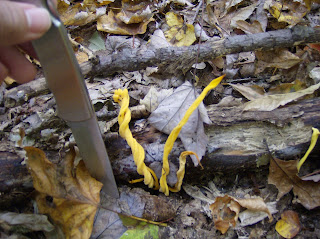I learned something very important and profound from this specimen...
it's a lot of fun to poke puffballs and see the spores shoot out. Yes, I admit to having some childish fun with my discoveries. If you can honestly say you would have done differently, you are a better person than I.
Figure 1. Calvatia excipuliformis (side view)
Figure 2. Calvatia excipuliformis (topside)
Name: Calvatia excipuliformis
Family: Lycoperdaceae
Collection Date: 10/11/2011
Habitat:“Solitary, scattered, or in groups in pastures, exposed soil, open woods, etc.” (Arora, 1986).
Location: Hiram College Field StationDescription: “Fruiting body top-shaped or pear-shaped…prominent stemlike sterile base. Outer layer of peridium white to grayish or occasionally yellowish-brown” (Arora, 1986).
“Narrower spore case [than the giant puffballs] (3-10 cm broad)…plus a narrower and greatly elongated (stemlike) sterile base. Widespread in wooded and open areas” (Arora, 1986).
Collector: Andrew Burns
Key Used: Arora. D., (1986) Mushrooms Demystified 2nd Edition, Ten Speeds Press, New York, NY
Keying Notes:
Major Groups of Fleshy Fungi… p.52
Lycoperdales & Allies (Puffballs and Earthstars)…677
1b. Fruiting body may rupture in starlike fashion but if so there is no separate spore case within…2
2b. Spore mass not containing peridioles…4
4b. Peridioles absent; spores produced in a single large chamber…5
5b. Spore mass becomes powdery with age…6
6b. Fruiting body above ground…7
7b. Spore mass does not have prominent veins running through it…8
8a. Sterile base present, often narrowed as a stemlike base beneath the spore case…9
9a. Fruiting body medium-sized to quite large, rupturing irregularly... Calvatia & Allies
Calvatia & Allies p.681
1b. Sterile base present…14
14b. Fruiting body without prominent warts…16
16b. Outer surface not bruising yellow…17
17b. Outer surface does not display red or reddish spots…18
18b. Spore mass ochre to brown, etc., but not purple…19
19b. Not as above…20
20a. Sterile base very prominent and elongated (up to 12 cm long) to form a stalklike base; spore case typically less than 8 cm broad and usually smaller in height than the sterile base… Calvatia excipuliformis
Correlating Links:


















